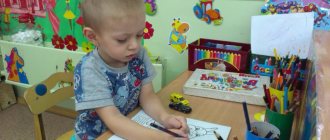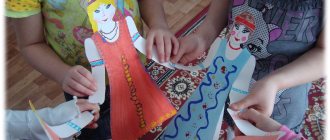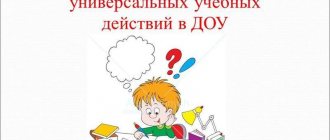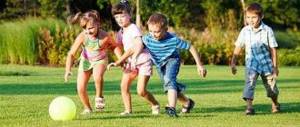Why is it important to develop a child’s speech?
It is known that correct and beautiful speech contributes to successful communication, learning and development of a child.
Competent, correct speech gives a feeling of self-confidence and allows you to find a common language with others. Children who speak well stand out from their peers in a positive way.
Timely development of speech allows children to actively explore the world and interact with it.
Experts say that recently the quality of children's speech has declined sharply. Many children have speech development disorders (incorrect pronunciation, inability to speak coherently, delayed speech development - SRD, etc.). There are reasons for this:
- deterioration of children's health;
- decreased amount of communication with others;
- long games with smartphones, watching cartoons too often;
- decrease in the speech culture of adults (foul language, filler words, incorrect use of word meanings, etc.);
- lack of speech education in the family.
Children's speech can and should be developed. Listening, reading and discussing children's fiction works well for this. In this way, the vocabulary is enriched, the child gets acquainted with the culture of speech, and learns emotional and intonation expressiveness.
There are also a variety of poems, songs and tongue twisters that not only develop speech, but also help solve speech therapy problems (for example, improve sound pronunciation).
Children's literature based on oral folk art is considered especially useful and close to children.
The use of folk art in the development of preschool children
About folk art.
Description of the material: I offer you material on the topic “folk art”. This material will be useful to employees of preschool educational institutions and parents. Through the sieve of centuries, the people have sifted their cultural heritage, leaving the most valuable in folklore, artistic crafts, decorative and applied arts. Folk art is an inexhaustible source of aesthetic, moral, and patriotic education of preschool children. Folk wisdom, contained in fairy tales, nursery rhymes, jokes, riddles, and sayings, has for many centuries fostered in children pride in the talent of the common people, interest in accurate, expressive words, and love for their native language. Children are very sensitive to well-aimed folk words. They use in their speech certain figurative expressions borrowed from folklore, memorize and enjoy reading nursery rhymes, and ask riddles. Objects of decorative and applied art are also of great interest: wood carving, embroidery, lace weaving, etc. The use of all these types of folk art in working with preschoolers enlivens the pedagogical process and has a special impact on the education of patriotic feelings.
Small folklore forms used in working with children reveal the picturesqueness of the Russian language. An appropriately read nursery rhyme, riddle, or counting rhyme improves children’s mood, brings a smile to a sad child, and calms a crying child. Kids love folk games accompanied by songs. Of particular importance is the introduction of small folklore forms and vivid folk expressions into the living spoken word. In the process of washing, dressing, getting ready for a walk, use a nursery rhyme, a riddle, or a joke. When introducing children to works of oral folk art, and above all to fairy tales, it is necessary to explain to children why a fairy tale is called a folk tale: “The grandparents of our grandparents knew this fairy tale. And it’s unknown who invented it, so they say it’s folk. Talented people have come up with many wonderful fairy tales.” Adults often do not attach importance to the methodology for performing fairy tales, due to which “the art of storytelling has almost degenerated in kindergarten pedagogy and has been replaced by reading.” A folk tale, by its nature, construction, means of expression and language, requires that it be told; this ensures contact with listeners and creates a certain mood in the children's audience. The impressions will be more vivid and powerful if you tell a fairy tale in national costume. When introducing preschoolers to proverbs and sayings, it is necessary to tell that people have created apt short expressions that ridicule laziness, praise courage, modesty, and hard work; explain when it is appropriate to use sayings and proverbs. Children gradually begin to use sayings themselves, their speech becomes more vivid and expressive. Children really enjoy free dramatizations of folk songs. A folk song should become an integral part of a child’s life, then it will be truly native, familiar to the child’s ears, like his native language. Kokoshniks, bast shoes, rockers and other attributes, in the preparation of which adults and children take part, complement the experience. You can introduce children to folk art at leisure evenings and at special holiday matinees. The work of introducing children to folk art is an important aspect of the overall work of developing patriotic feelings, nurturing love and interest in our Motherland, in its great people.
We recommend watching:
Educational game - activity in the first junior group of Kolobok. Scenario of a puppet show for preschoolers Consultation for parents of children 2-3 years old. Nursery rhymes Consultation for kindergarten parents on the topic: “Fairy tales”
Similar articles:
Quizzes for schoolchildren. Quiz about fairy tales and fairy-tale characters
Nursery rhymes and pesters for kids
Nursery rhymes and rhymes for finger games
Nursery rhymes
Nursery rhymes for children in the senior group of kindergarten
What are the benefits of developing speech with the help of folk art (folklore)
Folklore is oral folk art. This includes:
- fairy tales;
- epics;
- songs;
- Tongue Twisters;
- sayings;
- proverbs;
- nursery rhymes;
- puzzles;
- counting rhymes.
Folklore always contains interesting content and vivid images. It forms a positive attitude towards the world around us, develops the child’s imagination and speech, and also introduces folk traditions and culture.
Listening to Russian folk works and playing finger games with parents, the child develops.
For example, nursery rhymes often contain onomatopoeias of animals, which the little ones want to repeat.
With the help of rhythm and rhyme, which are present in poems, counting rhymes and nursery rhymes, the child learns intonation expressiveness.
Folklore enriches a child’s speech, increasing his vocabulary. Finger games with nursery rhymes develop fine motor skills, which, as you know, are closely related to speech.
These tongue twisters, nursery rhymes and even fairy tales are easy to remember; they train the child’s memory and activate speech. Children try to imitate the intonation and pronunciation of the characters.
There are not only Russian folk sayings, songs and nursery rhymes, but also modern ones that are more understandable to children. You can even find tongue twisters in a foreign language. Both are of great benefit for speech development.
Folk art in the education of preschool children
Irina Ryabova
Folk art in the education of preschool children
Folk art in the education of preschool children.
“Being able to raise children is a great matter of state, requiring talent and a broad knowledge of life.” M. Gorky.
In many ways, this knowledge comes from folk art - an eternal source of life experience, wisdom, and beauty. Folk art creates real prerequisites for the comprehensive harmonious development of man.
Now the national memory is gradually returning to us, and we are beginning to have a new attitude towards ancient holidays, traditions, folklore, artistic crafts, decorative and applied arts, in which the people left us the most valuable of their cultural achievements.
Love for Russian folk culture and its traditions must be instilled from childhood.
Introducing preschoolers to the traditions of the Russian people arouses interest in the past of their ancestors, expands knowledge and ideas about cultural heritage.
Folk works are the result of centuries-old human wisdom, the creativity of many generations . Therefore, from an early age you need to start introducing children to all types of folklore: songs, fairy tales, chants, riddles, proverbs and sayings, round dances, folk games . Russian folklore combines words, melodiousness, and rhythm. Thanks to this, folklore is a rich source of children's .
In oral folk art , special features of the Russian character, ideas about goodness, beauty, truth, courage, loyalty, and hard work have been preserved. By introducing children to fairy tales , sayings, riddles, and proverbs, we introduce them to universal moral values. Folklore works are the richest source of children's , they bring joy to the child, activate thinking, speech, memory, and imagination. Through oral folk art , a child masters his native language and masters beauty, and becomes familiar with the culture of his people . Oral folk art makes a child’s stay in kindergarten beneficial and joyful. This creativity stimulates the child’s creative manifestations , awakens imagination, enriches the personality, and his life becomes more interesting and meaningful. Gives children the opportunity to feel part of their people , their country, learn to respect and appreciate the past of their people .
Bright and imaginative products of decorative and applied art - the first touches to the world of folk culture , always cause delight and amazement in children.
It is very important to introduce preschoolers to the folk and applied arts of Dymka , Khokhloma, Gorodets, and Gzhel. This allows children by national fine arts. It reveals the best traits of the people , wisdom, courage, and the desire for beauty.
Looking at the beautiful paintings on spinning wheels and other household items; dishes; patterns on lace and embroidery; fancy toys, preschoolers get acquainted with folk , so we introduce them to their native culture, help them enter the world of beauty, teach them to see and feel the unique combinations of colors of nature, awaken the need to love and enjoy life. Through folk art , a child learns the traditions, customs, and characteristics of his people .
Folk art is a pure and eternal source. It has a beneficial effect on children , develops their creativity , equips them with knowledge, “brings beauty to children”
.
It comes from the soul, and the people’s soul is kind and beautiful .
The people showed their creative aspirations and abilities in creating objects needed in everyday life and work. In order for children to show curiosity about antiques, we, together with our parents, created a mini-museum “Russian Izba”
with
household . Children look with interest at the chest, stove, cast iron, stag, ruble, samovar, wooden spoons, embroidered towels, Russian folk costume and other exhibits. Surrounding objects have a great influence on the formation of a child’s mental qualities - they develop curiosity, cultivate a sense of beauty . Familiarization with folk art takes place in a “hut”
.
The children enjoy every meeting. With what admiration and joy children's when they visit the museum. Children are immersed in the world of Russian antiquity, communicating with time-cracked spinning wheels, rockers, irons and other items of folk life . They feel a living connection of times and seem to continue to be saturated with the “Russian spirit”
.
It is important to introduce children to ritual holidays. They are associated with various aspects of human social life, with labor. They contain people’s observations of the characteristic features of the seasons, weather changes, and the behavior of birds, insects, and plants. This folk wisdom , preserved over the centuries, must be passed on to children.
Introducing preschool children to traditional folk culture through folk holidays gives good results, as children show interest in folk culture and the history of the people , and show a sense of pride in their Fatherland.
Folk ritual holidays are always associated with the game. But folk games , unfortunately, have almost disappeared from childhood today. We must remember that folk games as a genre of oral folk art are national wealth, and we must make them the property of our children . Games develop dexterity, speed of movement, strength, accuracy, teach intelligence and attention. They have a lot of humor, jokes, and enthusiasm. The movements are accompanied by funny moments, children’s favorite counting rhymes, and toss-ups. Folk games form children's culture , maintain health and a healthy lifestyle.
One of the ways to introduce children to cultural heritage is through holidays and gatherings. Such holidays can include folk songs , playing folk instruments , round dances, ditties, and games. When selecting material for the holiday, it is necessary to take into account the age capabilities of children . Russian folk costume and the mumbling of participants at gatherings increases the emotional tone of children . The use of Russian costume helps children understand the Russian folk character . Holiday gatherings include work on developing communication skills between adults and children . Children look forward to the holidays that bring them together with joy and excitement. They are an unobtrusive form of introducing children to folk art .
Introducing children to folk art is a labor-intensive task , but it is in demand. Our task is to ignite a spark of love and interest in the life of the people , in their history and culture, to help us adults raise patriots . We need to strive to instill love and respect for folk art .
Tips for parents: where to start
- Children can be introduced to folklore from birth through lullabies and nursery rhymes.
- At an older age, works can be played out - for example, rocking dolls to lullabies, or organizing a puppet theater.
- Kids really enjoy playing together with an adult, when they can take the initiative (for example, a baby bends his fingers in “The White-sided Magpie”).
- Unfamiliar words need to be explained.
- It is better to tell fairy tales, nursery rhymes and poems in your own words.
- Folklore works must be presented emotionally and captivatingly, actively using facial expressions and gestures. Kids can put on a show with toys.
- When learning tongue twisters, you can engage your child in this way: tap a rhythm for each word or syllable with a ball, or arrange a competition: “Who can repeat the tongue twister 3 times without getting lost?”
Varieties of folklore for children's speech development
Tongue Twisters
Tongue twisters are short, rhythmic text that is deliberately created to make it difficult to pronounce sounds and words at a fast pace.
There are different types of tongue twisters, one of which your child will surely like.
Speech therapy tongue twisters
This type of tongue twister helps correct difficulties in pronouncing certain sounds. It is necessary to monitor the correct pronunciation and take your time at first. With systematic training, the child will easily learn to pronounce complex sounds (for example, R, L, Sh).
In the meadow under the hill lay a piece of cheese with a beautiful red rind. Forty forty in a short time They ate the cheese.
Tara-tara, tara-ra! Grass grows by the porch. Ay, tari-tari-tari, I’ll buy Rae litari.
The Turk smoked a pipe, The trigger pecked the grain: Don't smoke, Turk, the pipe, Don't peck the trigger, the grain!
Greek rode across the river. He sees a Greek - there is a cancer in the river. He stuck the Greek's hand into the river. Cancer by the hand of a Greek - DAC!
Tell me about your purchases. About what purchases. About purchases, about purchases, about my purchases.
In our lake, Andrey Thirty caught eels. Fry, smoke them and boil them - Very tasty eels.
Kapka has a sticky stick, On the stick there is sticky tow. Drops dripped from the stick, drops dripped from the tow, drops from the paw stained Kapke.
Funny tongue twisters
Kids love funny tongue twisters. They give a good mood and are easy to remember.
Beavers go into the pine forests. Beavers are kind, beavers are cheerful.
Have you washed the raspberries? They washed, but did not soap.
There were jackdaws visiting the wolf cubs. There were wolf cubs visiting the jackdaw cubs. Now the wolf cubs are making noise like jackdaws. And, like cubs, the cubs are silent.
The little turtle has turtle shoes on his little turtle little hands.
They stomped and stomped, they stomped until they reached the poplar, they stomped until they reached the poplar, but they stomped their feet.
The hedgehog has a hedgehog, the grass snake has a snake.
The Christmas tree has pins and needles. Splitting needles near the Christmas tree.
Modern short tongue twisters
- The prince invited the princess to take a walk along the avenue.
- Three hundred thirty-three boxes, and there are three corks per box.
- Pashka has bugs and pieces of paper in his pocket.
- The red crab shouts “Hurray!”, it’s time to cut the cake.
- Centipedes have too many legs.
- Sasha walked along the highway and sucked on a dryer.
- Thunder struck - a thunderstorm was in full swing.
- Skinny, weak Kashchei is dragging a box of vegetables.
Complex tongue twisters
These tongue twisters will appeal to older preschoolers (5-7 years old).
The longboat arrived at the port of Madras. The sailor brought a mattress on board. In the port of Madras, a sailor's mattress was torn apart in a fight by albatrosses.
Old talkative women live in a hut at the edge of the forest. Every old lady has a basket, There is a cat in every basket, Cats in baskets sew boots for old ladies.
Once upon a time I gave a crucian carp a coloring book. And Karas said: “Color, Karasenok, the fairy tale!” In the coloring book Karasenka - Three cheerful little pigs: Karasenka repainted the piglets into crucian carp!
You stained even your neck, even your ears with black mascara. Get in the shower quickly. Rinse the mascara off your ears in the shower. Rinse off the mascara from your neck in the shower. After your shower, dry yourself off. My neck is dry, my ears are dry, and don’t dirty your ears anymore.
Whoever wants to talk must pronounce everything correctly and clearly, so that everyone can understand. We will talk and we will pronounce it so correctly and clearly, so that everyone can understand.
Count Toto plays lotto, And Countess Toto knows that Count Toto plays lotto, If Count Toto knew that Countess Toto knows that Count Toto plays lotto, Count Toto would never have lived I wouldn't play lotto.
Coconut cookers boil coconut juice in coconut cookers.
Tongue twisters for the development of speech of children 3-4 years old
At this age, short and simple tongue twisters with understandable words are suitable.
Al-al-al - the hare galloped across the field, Ol-ol-ol - he found a carrot there, Il-il-il - a friend asked him, Is-is-is - you share with me, Al-al-al - he I gave a carrot to a friend.
Ivashka has a shirt, the shirt has pockets, Pockets have a shirt, Ivashka has a shirt.
The hedgehog has a hedgehog, and the grass snake has a hedgehog. Snakes don’t live where hedgehogs live.
Oh, kachi-kachi-kachi. We are rooks, we are rooks.
There is grass in the yard, There is firewood on the grass, There are children on the firewood.
On the window, a tiny midge is deftly caught by a cat with its paw.
Tongue twisters for the development of speech of children 5-6 years old
Children of this age can be offered longer tongue twisters with old Russians - not difficult! - words to enrich your vocabulary. And funny tongue twisters will cheer you up.
By the river, by the river Only the girls gathered. Along the river, Along the river they went to collect shells.
Needle-needle, You are sharp and prickly, Don’t prick my finger, Shay my sundress.
Bananas were thrown to a funny monkey. Bananas were thrown to a funny monkey.
Kirill bought a jar and a mug at the market.
The brawler ram climbed into the weeds.
The crow missed the little crow.
Kondrat's jacket is a little short.
Vlas is with us, Afanas is with you.
Tongue twisters for the development of speech in children aged 7
Children 7 years old can be offered complex tongue twisters, with a fairly large number of unfamiliar old words. This will expand your horizons, vocabulary and improve memory.
In our courtyard, the weather has become wet.
The boletus is running - White-tailed, white-footed, Rummaged through the whole yard.
There are bells near the stake, and bells on the stakes. Koval Kondrat forged steel, forged and reforged.
Emelya spends a week spinning a box of tow, and Emelya’s daughter spends one night spinning.
The farrier forged the horse, the Horse with the farrier’s hoof, the Farrier with the horse’s whip.
Where does the millet come from in the clearing? We simply spilled millet here. We found out about millet. Without asking, they pecked up all the millet.
The goldfinch chirped with the goldfinch, Tickled his goldfinches, And the goldfinch-finch And the goldfinch-finch squeaked at the goldfinch.
Tongue twisters for the development of speech and diction
In order for such tongue twisters to bring maximum benefit, they should be learned as follows:
- first pronounce silently, but with articulation;
- then say it in a whisper
- pronounce the tongue twister out loud, first slowly, then faster and faster.
It is important to ensure that sounds are pronounced clearly and correctly.
- The waxwing whistles with a flute.
- Thirty-three ships tacked, tacked, but did not tack.
- The snout pig was white-nosed, blunt-nosed; I dug up half the yard with my snout, dug, dug.
- We ate and ate ruffs at the spruce tree. They were barely finished at the spruce.
- The hedgehog has a hedgehog, the grass snake has a snake.
- You can’t say all the tongue twisters too quickly.
- The crab made a rake for the crab, gave the rake to the crab - rake the gravel with the rake, the crab.
- Karl stole corals from Clara, and Clara stole Karl's clarinet.
- The Queen gave the gentleman a caravel.
On the role of oral folk art in raising children
Nasibullina S.L., Kuryshova I.A. On the role of oral folk art in raising children // Sovushka. 2020. N 3 (17). URL: https://kssovushka.ru/zhurnal/17/ (date of access: 10.10.2020).
Order No. 400279
“The spiritual life of a child is complete only when he lives in the world of games, fairy tales, music, and fantasy. Without this, he is a dried flower."
V.A. Sukhomlinsky
The importance of works of oral folk art in the process of education and development of a preschool child is great. Folklore is a source of pedagogical influence on preschoolers, the basic basis for the education of morality, aesthetic feelings, and patriotism. In the process of its development, there is a huge impact on the emotional and moral spheres of the child [1, p.4].
The functions of educating oral folk art are that it promotes the understanding of such categories as good-evil, generosity-greed, honor, modesty, duty, etc. Russian folklore is comparable to a pure spring, after drinking from which a child gets to know his native people in his heart, becomes the spiritual heir of his traditions, which means he grows up to be a real person [1, p.7].
Already at an early age, a child encounters nursery rhymes, which represent one of the small forms of folklore works. For the child, the semantic content, the rhythm of words, and the ability to perform various actions when pronouncing the text become important. He experiences an emotional outburst, and this also helps to change his behavior, especially during the period of getting used to the conditions of being in kindergarten. With the help of a nursery rhyme or folk song, you can switch the child’s attention to some toy, evoke positive emotions towards the teacher, develop a sense of the need to perform such routine moments as sleeping, washing, combing one’s hair, eating, etc.
A fairy tale is a special means of educating a preschooler’s morality. She helps to demonstrate that friendship can overcome evil, that evil is always punished, and good deeds are always rewarded. Usually, positive heroes of fairy tales have character traits and intellectual abilities that are more valuable to a person. The child learns to evaluate the actions of positive and negative heroes, to find ways to help and protect the deceived and offended. Thanks to fairy-tale heroes, the child begins to understand what he should strive for and what actions to perform. Fairy tales always contain a lesson that the child learns for himself. Moral education is possible through all types of folk tales, because morality is initially inherent in their plots [3, p.31]. According to K.I. Chukovsky, a fairy tale improves, enriches and humanizes the child’s psyche, since the child feels like an active participant in it and always identifies himself with one of its characters fighting for good. This sympathy of children for the heroes of a fairy tale lies the main educational meaning of a fairy tale” [12].
In addition, based on the plot of a fairy tale, one can teach the basics of life safety, introduce dangerous aspects that can await a child in real life, and also draw parallels with reality [5, p. 124].
Works of oral folk art are a special means of forming and nurturing patriotic feelings in preschool age. They contain specific facts and images of heroes that arouse children's interest. A special place here is occupied by heroic tales, which tell about the heroic deeds of characters during the liberation of their people, their native land from enemies and evil spirits. K.D. Ushinsky considers children’s interest in various works of folklore as “an indicator of an emerging feeling of love for their native land, its history, nature, and people’s work” [7, pp. 13, 16, 17].
It is impossible not to note the importance of oral folk art for the formation of cognitive interest. “Fairy tales, depending on the topic and content, make listeners think and make them think. Often a child concludes: “This doesn’t happen in life.” The question involuntarily arises: “What happens in life?” Already the conversation between the narrator and the child, which contains the answer to this question, has educational significance. But fairy tales also contain educational material directly. It should be noted that the educational significance of fairy tales extends, in particular, to individual details of folk customs and traditions and even to everyday trifles” [2, p. 122]. For example, the Russian folk tale “Kolobok” introduces children to traditional Russian cuisine, the recipe for making kolob, and concepts such as “barn”, “susek”, “yarn”, thereby broadening their horizons and introducing them to the origins of the Russian language [16, p.24, 26].
Folklore reveals all the delights of the Russian language and enriches the speech of a preschooler. According to K.D. Ushinsky, “folklore texts awaken to life the seeds of the native word, which are always rooted, albeit unconsciously, in the soul of a child” (8, p. 298). Works of folklore allow a child to immerse himself in the beauty of his native language and influence the imagery of speech. Even the great children's writer K.I. Chukovsky in his book “From Two to Five” said that “all kinds of folk songs, fairy tales, proverbs, sayings, riddles, which constitute the favorite mental food of preschoolers, best introduce the child to the basics of folk speech” [12 ].
In works of oral folk art that influence environmental education, the connection between man and nature is very clearly visible. This is how numerous proverbs reflect observations of natural phenomena and their power. Round dance is an action that is completely connected with nature. Thus, nurturing love for native nature can also be based on folk pedagogy [4, pp. 42-44].
In addition to works of Russian folklore, works of folklore of the peoples of the world should also organically fit into a preschooler’s reading circle, which introduce the child to national cultures, instilling him in universal values. By comparing the works of different nations, the child gets the opportunity to make an initial analysis of national characteristics, which contributes to the understanding of common moral positions and common goals of the folklore of each nation [7, p.16].
In conclusion, we emphasize once again that the role of folklore in raising a child is limitless. Oral folk art has an educational effect on the development of personality, feelings, character traits that connect a child with his people through songs, games, dances, fairy tales, etc. This is a source of pedagogical material, the basis of speech, moral, aesthetic, patriotic, and environmental education. Using the heritage of the people in work enlivens the pedagogical process.
Literature:
- Vikulina A.M. Elements of Russian folk culture in the pedagogical process of a preschool institution. N. Novgorod: Nizhny Novgorod Humanitarian Center, 1995. 138 p.
- Volkov G.N. Ethnopedagogy: textbook. for students avg. and higher ped. textbook establishments. M.: Academy, 1999. 168 p.
- Zimina I. Folk tale in the system of education of preschool children // Preschool education. 2005. No. 5. pp. 28-35.
- Nikolaeva S. On the possibilities of folk pedagogy in the environmental education of children // Preschool education. 2009. No. 4. P.42-46.
- Pidruchnaya S. Fairy tales - for the safety of children // Preschool education. 2008. No. 2. pp. 124-127.
- Poshtareva T. The use of folk tales in the educational process // Preschool education. 2009. No. 5. pp. 24-28.
- Ushinsky K.D. Native word. Collected Works, M.: 1974.
- Ushinsky K.D. Collected works. T.6. M., 1948.
- https://nsportal.ru/detskiy-sad/razvitie-rechi/2017/09/05/rol-ustnogo-narodnogo-tvorchestva-v-vospitanii-detey
- https://infourok.ru/rol-ustnogo-narodnogo-tvorchestva-v-vospitanii-detey-mladshego-doshkolnogo-vozrasta-1906816.html
- https://moluch.ru/archive/179/46317/
- Chukovsky K.I. From two to five. URL: https://www.gumer.info/








